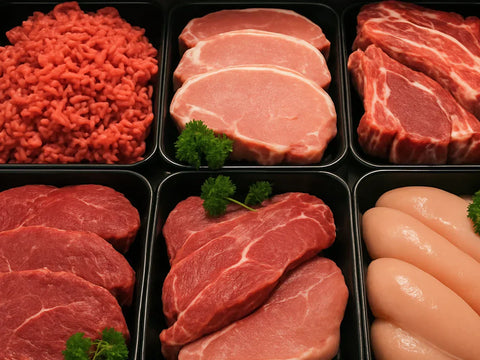Tips for Proper Meat Storage
Proper meat storage is essential to maintain its quality and safety, whether you buy from a local butcher shop or a meat market in Riyadh. In this article, we’ll review the best practices for storing meat to ensure it stays fresh and safe for consumption. Good storage requires a deep understanding of meat characteristics and how to handle it from purchase to consumption.
Benefits of Proper Meat Storage
Preserving Quality
Good storage helps maintain the flavor and texture of meat, enhancing the cooking and dining experience. Properly stored meat remains tender and delicious, making it ideal for preparing a variety of dishes. High quality means the meat retains its taste and nutritional value longer.
Food Safety
Correct storage reduces the risk of food poisoning by preventing harmful bacteria growth. Bacteria such as Salmonella and E. coli can multiply quickly if meat is not stored under the right conditions. Keeping meat at low temperatures significantly reduces the chance of bacterial growth.
Cost Savings
Proper storage reduces waste, saving you money in the long run. Meat stored in the right conditions won’t spoil quickly, meaning you get the most out of every purchase. Additionally, good storage allows you to buy in bulk when special offers are available and store it for future use without losing quality.
How to Store Fresh Meat

Choosing Fresh Meat
When buying meat, whether from a meat center or imported suppliers, choose fresh cuts with good color and a natural smell. Avoid meat that shows signs of spoilage or has an unpleasant odor. Prefer firm cuts that are not sticky, as this indicates high quality.
Correct Temperature
Store fresh meat in the refrigerator at a temperature not exceeding 4°C. This slows bacterial growth and keeps the meat fresh for as long as possible. Use a fridge thermometer to ensure the temperature remains within the safe range. Avoid frequent opening and closing of the fridge to maintain stable temperatures.
Meat Packaging
Always wrap meat properly before placing it in the refrigerator. Use airtight bags or butcher paper. Removing air from the packaging prevents drying and bacterial growth. Double wrapping is recommended for larger cuts or longer storage periods to maintain moisture and flavor.
How to Store Frozen Meat

Preparing for Freezing
Before freezing, cut the meat into suitable portions and wrap it properly. Use freezer-safe bags or airtight plastic containers. Remove as much air as possible to prevent freezer burn, which affects taste. Portioning meat makes it easier to use later.
Storage Duration
Frozen red meat can be stored for up to 12 months without losing quality, while poultry can be kept for 6–9 months. Always label packages with the freezing date to manage inventory. Review your stock regularly to ensure usage before expiry, reducing waste.
Thawing Frozen Meat
For best results, transfer frozen meat to the refrigerator 24 hours before use. This ensures even thawing and minimizes bacteria risks. Avoid thawing meat at room temperature. Microwave thawing is an option for quick defrosting but cook immediately afterward for safety.
Extra Meat Storage Tips
- Organize the fridge and freezer: Place meat in the coldest areas and avoid overcrowding.
- Check expiration dates: Regularly monitor expiration dates to ensure meat is used before it spoils.
- Handle with care: Use clean tools and wash hands after handling raw meat to prevent cross-contamination.
Taking Advantage of Offers

Many butcher shops offer special deals on fresh and imported meats. Buying in bulk during these offers saves money, but be sure you can store them properly to avoid spoilage. You can also use offers to try new cuts and recipes with confidence.
Conclusion
Proper meat storage requires planning and attention to detail, but it’s an investment in your food quality and health. By following these tips, you ensure the meat you buy—whether fresh or chilled—stays in top condition for as long as possible.
With proper storage, you’ll enjoy tasty, safe meals while reducing waste and saving money. Adopting smart storage practices isn’t just a good habit—it’s part of a healthy and responsible lifestyle.








Comments (0)
There are no comments for this article. Be the first one to leave a message!